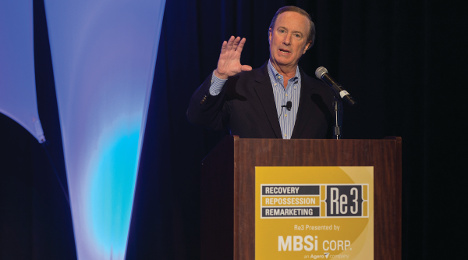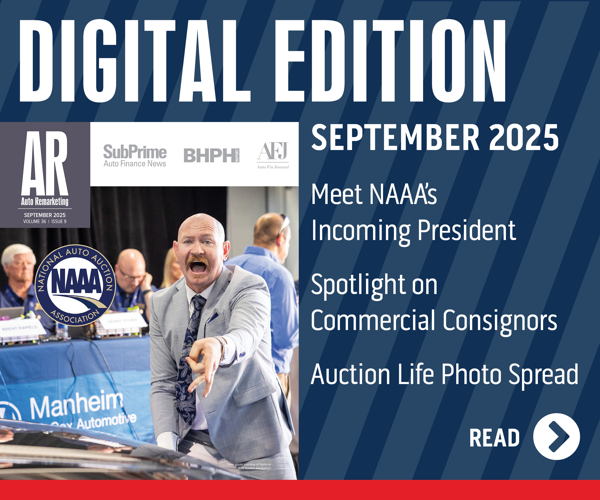RouteOne unveiled a pair of solutions aimed at helping dealerships and finance companies complete vehicle deliveries and documents in the showroom or wherever the purchaser might be.
On Monday, RouteOne launched remote document delivery; what the company explained is a new technology that can securely and compliantly give consumers electronic access to their eContracted documents. At the same time, the tool can reduce printing costs and paper shuffling for dealers.
Paradoxically, RouteOne acknowledged the eContracting process still involves paper, and can result in printed review and signed copies of retail and lease contracts. The company noted paper has remained part of the process, in part, because of compliance requirements surrounding providing consumers with copies of their contracts that they can take with them. Previously, the only way to accomplish this requirement was the paper option.
With RouteOne’s remote document delivery technology, the company explained the need to print review and final copies of retail and lease contracts is alleviated.
Now with a click of a button and the consumer’s email address, dealers can send their customers a secure link to access their files.
As an option, customers can review the documents in the dealership on their own smartphone or tablet. They can also log in at home to review, save or print them for later reference.
“We listened, we heard and we responded,” RouteOne chief executive officer Justin Oesterle said. “Our dealers told us they love eContracting, but they wanted less paper. Remote document delivery came from listening to our customers.
“We often refer to RouteOne as the company that is ‘designed by dealers for dealers’, and this is a great example of how we strive to make that happen,” Oesterle continued.
The new technology, led by Toyota Financial Services and Ford Motor Credit, is now available functionality for RouteOne eContracting. As part of RouteOne’s commitment to making eContracting better and better, it is provided at no charge.
In the future, the company added the documents available in remote document delivery will continue to expand as RouteOne continues to advance eContracting.
Details of RouteOne’s new digital retail platform
Meanwhile, RouteOne highlighted its new digital retail services can provide dealerships with an online credit application containing dealer-selected branding along with a mobile point of sale application to accommodate consumers’ growing demands for a seamless transition to, and greater flexibility within, the in-store vehicle purchasing process.
RouteOne wanted to give dealers this easy-to-use technology, allowing their customers to complete a credit application themselves or as guided by the dealer. This process can occur online from the dealer’s website, in the dealer’s showroom, or wherever a deal may happen — from any mobile device.
The mobile point of sale app included in RouteOne’s digital retail services, not only can provide flexibility, but also enables consumers to eSign the credit application. Compliance features, including credit score disclosure notice, privacy policy and identity verification, can be automated for every online application to assist dealers in managing their regulatory requirements.
RouteOne chief strategy officer Todd Mason pointed out that dealers who have made the shift have found that RouteOne’s digital retail services can reduce errors and missing information, which can expedite the deal funding process. The information captured in the online credit application can flow directly into a RouteOne eContract, creating a seamless, digital F&I experience.
“Providing dealers with the ability to conduct business online is not new territory for RouteOne,” Mason said. “However, as the consumer’s journey changes and business models evolve, so will our technology.
“This new digital retail platform responds to the growing need for greater flexibility within the vehicle purchasing process,” he went on to say.
To learn more about RouteOne’s new tool, visit routeone.com/dealers/digital-retail-services.
Whether it’s during an industry-wide conference or in one-on-one client sessions, finance companies often pepper Anil Goyal with questions. The senior vice president of automotive valuation and analytics for Black Book mentioned some common ones such as, “Can you tell me why this segment is performing well? Why not? Where is the supply or demand? Can you tell me how the segment has performed in the past five years?”
To provide finance companies more opportunities to ask those questions — and perhaps more importantly receive what Black Book considers to be reliable answers — the company introduced Visual Analytics, a subscription-based interactive data solution that can enable users to easily unearth and gain insights on outcomes leveraging historical, current and projected vehicle and segment valuation data.
SubPrime Auto Finance News joined the stream of posing questions to Goyal, who shared a demonstration of Visual Analytics during this week’s Vehicle Finance Conference in New Orleans hosted by the American Financial Services Association. Goyal showed how the browser-based application produces information through a dashboard presentation.
The tool can offer metrics going back nearly two decades as well as Black Book projections that look ahead for the next couple of years.
“My excitement is more about leveraging this tool to help deliver insights and inform lenders on where the trends are going to help them make better decisions,” Goyal said. “What’s happened in the last five years, we’ve had such a strong market both in terms of lower delinquencies along with growth and demand coming up and retail values being so strong. It’s all been very positive.
“Now some of those positive trends are turning,” he continued. “Delinquencies are rising and vehicle values are going down. Pent-up demand has been spent. There are more plateauing of those positive trends as some of the negative trends are starting to creep in. That means you need to make smarter decisions. Just being in the business is not enough. You’ve got to get ahead of that competition. You have to understand what your data is saying. You have to know where you can fine-tune your portfolio. That’s where the value comes in.
“Five years ago, it might not have been that relevant because everyone was winning. But data analysis and visually delivering it have been more and more critical for some to say, ‘I get it,’” Goyal went on to say.
Here are six of Visual Analytics’ capabilities and features designed for auto finance company managers and other industry professionals to “get it,” including:
• Realize in-depth market trend analysis to see a holistic picture of the used-vehicle market and see where collateral values are trending historically and current day.
• Detailed residual value projections that offer visibility and forecasting from a predictive modeling approach on individual vehicle models and ranking within segments on where collateral trends are projected to go.
• Gain insight to help fine-tune loss forecasting so that lenders can minimize and mitigate potential loss resulting from falling values and delinquency rates.
• Identify new and emerging opportunities based on collateral trends that show growth potential across each of the vehicle segments, opening up avenues for segment growth in portfolios.
• Understand depreciation trends that are critical to healthy and profitable portfolio growth.
• Explore robust data based on the Black Book’s accurate valuations data.
“If you’re looking for something in this space, we have all of the information right here for you,” Goyal said. “These are the kinds of insights where you would have to get a lot of data and an analyst. There’s a lot of talk about data analytics, but it requires a lot of effort, too. We want to simplify analytics like this and make it available to our lending customers.”
Finance company clients also can upload data to Black Book — sets that do not include personal customer information — and Visual Analytics can run various reports about that credit provider’s portfolio. Goyal highlighted the tool can determine how much exposure a portfolio has to certain segments and even specific models that have gone through various changes involving demand, depreciation and more.
“These insights will really help them understand what’s going on in the market, the history and where it might be going,” Goyal said.
To schedule a demo of Visual Analytics, or to learn more about the solution, visit blackbook.com/solutions/visual-analytics.
Within weeks of reaching a partnership with a subprime auto finance company, AutoGravity — a FinTech developer on a mission to transform auto financing by harnessing the power of the smartphone — announced on Wednesday that potential buyers in 46 states can obtain up to four financing offers on any make, model or trim of new or used vehicle.
Shoppers can receive their offers through four steps on the AutoGravity platform, which can return personalized retail installment contract and lease offers within minutes.
“AutoGravity has brought car finance into the digital age,” said Andy Hinrichs, who became AutoGravity’s founder and chief executive officer after decades as an auto finance executive.
“Our industry-leading technology has been embraced by top banks and captive auto lenders, as well as leading dealer groups who see customers shopping on their smartphones every day,” Hinrichs continued in a news release. “We’ve re-designed the car finance experience, taking it from hours to minutes for car buyers across the country.”
Earlier this month, the firm finalized a partnership with First Investors Financial Services, bringing the subprime auto finance company’s indirect financing business onto the AutoGravity platform.
Based in Irvine, Calif., AutoGravity said it has built other partnerships with the world’s leading banks, captive finance companies and leading dealership groups. As a result, AutoGravity claims to be the only company to successfully bring thousands of dealers and an extensive list of top global finance companies together in a single, convenient digital marketplace.
“To truly empower car buyers with access to every possible vehicle, dealer and finance choice, the AutoGravity platform must be an attractive place for lenders and dealers to do business,” said Serge Vartanov, AutoGravity’s chief marketing officer.
“We’ve spent over a year integrating lenders and dealers into the platform, and we’re now ready for customers across the country to start shopping and financing —making AutoGravity a game-changer in the auto-finance industry,” Vartanov continued.
The app can guide vehicle shoppers through an intuitive four step process:
1. Select any make, model and trim of new or used vehicle available in the United States.
2. Select any dealership from AutoGravity’s proprietary national database; the platform automatically pinpoints the location and shows the closest dealers selling the vehicle.
3. Search for financing for the selected vehicle on a smartphone. Users can scan their driver’s license and connect to social media to quickly pre-fill the finance application.
4. Receive up to four finance offers within minutes. They can select the retail installment contract or lease offer that’s right and head to the dealership to complete the delivery.
“AutoGravity’s highly-streamlined process is designed to address the shopping habits and demands of modern consumers, particularly millennials,” the company said. “This is made possible through AutoGravity’s unparalleled technical expertise, partnerships with the world’s most prominent lenders and a proprietary database of trusted dealerships.
Designed with state-of-the-art security, AutoGravity protects consumers’ information with advanced bank-level encryption and proprietary data security technologies, ensuring sensitive information is processed in a safe and secure way,” the company went on to say.
The app is available for download on from the Apple App Store and from Google Play. AutoGravity is also available as a mobile-responsive web-app at www.autogravity.com.
The American Financial Services Association made the decision not long before the holidays to add another special panel discussion to its Vehicle Finance Conference; a segment dedicated solely to the subprime segment and to assuage concerns of a “bubble.”
In front of a standing-room only audience at the Sheraton New Orleans, a trio of experts from each of the three major credit bureaus to varying degrees all emphasized that there is no bubble, and the amount of subprime auto paper still outstanding is actually less than where it stood before the Great Recession.
AFSA gathered together Equifax chief economist Amy Crews Cutts, Experian senior director of automotive finance Melinda Zabritski and Jason Laky — who is senior vice president and automotive and consumer lending business leader at TransUnion — for a session ahead of the main festivities at the conference that began later on Tuesday.
Each of the experts took turns dissecting various parts of the subprime auto finance market, maintaining that it’s not “bubbling” like some media outlets might speculate while circling back to the mortgage meltdown that derailed the economy.
“People don’t buy cars to flip them. They buy them to get to work,” Crews Cutts said. “There’s definitely not a bubble.”
Later Laky added, “It’s such a different part of the economy than mortgage.” And when speaking about subprime auto paper being booked nowadays, Laky said, “We’re still not even up to where we were back in 2009.”
Zabritski also chimed in, saying, “We had this massive trough in 2009 where there wasn’t any funds to lend. We’re seeing the market turn around with higher scores in longer term loans.”
The 45-minute session moved quickly as the assembled panel touched on elements of the subprime space that are now different than perhaps 10 years ago, especially with the advent of alternative credit data that can present a more detailed background about a consumer’s past performance.
However, each credit bureau shared some concerns about subprime auto finance.
Laky mentioned that terms stretched to 75 months are fine, if the consumer actually has the budget capacity to maintain the payment commitments.
Zabritski noted that loan-to-value ratios often are at 110 percent and higher, even when a buyer makes a 10-percent down payment. That’s because of all of the taxes, fees and other ancillary costs that go into delivery.
Crews Cutts pointed out how it’s important to watch trend data about payment performance of subprime borrowers with regard to all of their monthly commitments because sometimes their ability to handle their finances can produce a “train wreck.”
Editor’s note: Much more coverage from the discussions and presentations during AFSA’s Vehicle Finance Conference will be included in upcoming reports from SubPrime Auto Finance News.
While the American Financial Services Association firmly is entrenched within the Capitol Beltway in Washington, D.C., the organization strives to represent the entire industry, not just a select group of players. AFSA president and chief executive officer Chris Stinebert reinforced that reasoning when describing the AFSA Vehicle Finance Board.
Stinebert said that board “features a broad cross section of companies: banks, captive finance companies and independent finance companies. Each member uses the indirect channel to finance new and used cars, trucks and motorcycles — meaning they purchase the loans from dealers and do not make auto loans directly to consumers.
“Indirect lending has proven to be the most cost effective and convenient way for consumers to finance a vehicle,” he continued. “Although each company competes fiercely for business, they all have common interests and concerns. This is the glue that binds.”
Those fierce competitors will be gathering together this week in New Orleans as AFSA hosts its annual Vehicle Finance Conference beginning. As usual, the gathering of auto finance company executives, legal experts and other service providers comes just ahead of the National Automobile Dealers Association Convention and Expo, also being conducted in the Big Easy.
“We have a wonderful working relationship with NADA,” said Stinebert, who again incorporated NADA leadership into the Vehicle Finance Conference program.
“Our relationship with NADA has been so productive because we look at the industry from the consumer’s point of view,” he continued. “We’re really talking about the same transaction.
“Both of our organizations represent members who have the same responsibility — to provide consumers with a smooth, transparent, and easy-to-understand vehicle purchase and financing process,” Stinebert added.
This year’s conference theme asks the provocative question, “Are we there yet?”
Stinebert said, “Our theme may remind you of a long road trip with your kids and sounds a bit odd. But it raises an extraordinarily important question. It provokes our members to ask themselves if their companies are 'there yet' on issues like compliance, cyber security, customer satisfaction and technology.
“We’re attempting to answer that question — sessions are focused on giving our members the tools and knowledge to make that journey,” he continued.
Josh Linker, an entrepreneur and hyper-growth CEO who has spent his career harnessing the power of disruptive change, will present the conference keynote. He will deliver a clear call to action for members — it is better to innovate and disrupt your organization before your competition does. The riskiest move companies can make today is embracing the status quo — believing the future will be like the past is the fast road to obsolescence.
Another important session will feature the three major credit bureaus coming together “to set the record straight” on the health of the subprime auto finance market. The experts scheduled to be a part of that discussion are:
— Denise Brown, chief risk officer Veritas Auto Finance and chair of the AFSA Vehicle Credit Risk Committee.
— Amy Crews Cutts, senior vice president and chief economist at Equifax Automotive Services
— Jason Laky, senior vice president and auto business lead atTransUnion
— Melinda Zabritski, senior director at Experian
David Paul (Vehicle Finance Division chair and senior vice president, financial services at American Honda Finance Corp.) and Mark Scarpelli (incoming NADA chairman and President of Raymond Chevrolet and Kia) will kick off the final day of the conference with a frank discussion about the important relationship between dealers and financing sources.
AFSA’s CEO Panel will feature key industry executives sharing best practices, compliance hurdles, and critical opportunities in the fast-moving marketplace of auto finance. That executive group is set to include:
— Jason Grubb, chief executive officer at Exeter Finance Corp.
— Dale Jones, executive vice president, Americas with Ford Motor Credit
— Mark O’Donovan, chief executive officer of Chase Auto Finance
— Vince Rice, executive vice president and consumer finance division head with Bank of the West
Organizers highlighted registration for the conference has grown steadily over the last decade. AFSA added that attendance at the 2017 conference has set a new record as more than 600 attendees will gather in The Big Easy to network, learn from the experts, and visit the conference’s more than 55 exhibitors.
Not only collaborating for this annual event, Stinebert touched on how else AFSA and NADA are working together so the financing of vehicle transactions goes well for all parties involved.
“One of AFSA’s core competencies is to educate politicians, regulators and most importantly, consumers, about the benefits of the auto financing process and the industry,” Stinebert said.
“This past year, in conjunction with the Federal Trade Commission and NADA, AFSA updated the Understanding Vehicle Financing brochure. This publication is a must read for anyone who wants to finance a car, including regulators and politicians,” he continued.
“Today, more than ever, consumers are going online to not only research certain vehicles in certain segments, but also to research the best way to finance and pay for their vehicles,” Stinebert went on to say. “In addition to constant dialogue with Capitol Hill staffs and regulators, this year AFSA and NADA are updating and modernizing the website for AWARE, an acronym for Americans Well-informed on Automobile Retailing Economics. This is a joint project shared by the two trade associations and their members. It is devoted to educating consumers about auto financing.”
As the industry descends into New Orleans, Stinebert shared his assessment of how the auto finance market behaved in 2016.
“We entered the year with concerns about The New York Times editorial on the pending subprime auto bubble and we ended 2016 with a huge sigh of relief,” he said. “Instead of disaster, we have enjoyed a very successful year of record sales.
“More importantly, the credit bureaus recently reported improved data on average credit scores and delinquencies, so no bubble and no crisis,” Stinebert continued. “This does not mean, however, we do not have many challenges going forward. But the looming regulatory and compliance issues facing the used-car market should see promised relief with the election of Donald Trump.”
Editor's note: Watch for updates from the Vehicle Finance Conference on our website as well as our Twitter feed at @SubPrimeNews.
White Clarke Group is continuing to organize discussions about how the growing development of blockchain might “revolutionize” the auto finance industry.
During White Clarke Group’s Auto Captives Summit back in November, Danny Williams, chief innovation officer at IBM UK explained how blockchain technology can be used to efficiently track a vehicle from the moment it is assigned a VIN through to the very end of its life.
Williams also referenced the benefits blockchain could bring to the auto finance industry by increasing trust, reducing risk, eliminating intermediary costs and saving time.
Williams’ presentation can be seen here as well as the window at the top of this page.
Williams isn’t the only expert highlighting blockchain’s possibilities
Late last year, Toyota Financial Services (TFS) made the corporate decision to join R3’s CEV blockchain consortium to explore distributed and shared ledger technology for potential applications in auto financing.
TFS thus became the first global auto finance captive to collaborate with more than 50 of the largest financial institutions in R3’s network on developing use cases for blockchain in the financial industry.
Chris Ballinger, who is chief financial officer and chief officer of strategic innovation at Toyota Financial Services was at the forefront of the deal, saying that blockchain “will ultimately lower costs, increase efficiency, and make auto finance more transparent.
“We can all agree, that’s the future, some are just disagreeing on the timing of it,” Ballinger continued. “However, financing products for those markets have not been developed yet. You just see little experiments, and I think that’s big change and the big opportunity for auto finance. It’s a big market, huge, and question is how do we finance it, and make it affordable."
The event White Clark Group hosted extended a string of blockchain discussions the company was involved in a year ago.
Outside the discussion groups, White Clark Group said developers are experimenting with blockchain applications, but as yet there have not been any large scale projects built around blockchain technology that are not bitcoin or “altcoin” related.
“The appetite for extending its use however, seems to be massive,” the company said.
The American Financial Services Association’s Vehicle Finance Conference last year in Las Vegas dedicated an entire keynote presentation to blockchain technology. Haskell Garfinkel, fintech co-lead at PricewaterhouseCoopers, made the presentation, which can be watched here thanks to sponsorship by White Clarke Group.
AutoGravity, a FinTech developer on a mission to transform auto financing by harnessing the power of the smartphone, this week announced a partnership with First Investors Financial Services, bringing the finance company’s indirect financing business onto the AutoGravity platform.
The newly announced partnership expands the financing options available to a growing generation of customers seeking the convenience and empowerment that come with using the AutoGravity iOS, Android or Web App.
The AutoGravity app can connect consumers to finance companies and dealerships using a seamless digital platform. Shoppers can choose any new vehicle, find a dealership that sells the model, apply for financing and select from up to four personalized finance offers. They can then take their chosen offer to the dealership to seamlessly lease or purchase the vehicle they’ve selected.
“Our partnership with AutoGravity helps us reach a new generation of customers and positions us to stay ahead of innovation,” said Tommy Moore, president and chief executive officer of First Investors Financial Services.
“We are excited to work with AutoGravity and utilize cutting-edge technology to meet the needs of our customers and dealers while enhancing our presence in the market,” Moore continued.
Headquartered in Irvine, Calif., AutoGravity was founded by an international team of digital natives and industry veterans on a mission to realize the full potential of smartphone technology to empower customers with vehicle finance offers.
As an early adopter, First Investors can reach digitally-savvy millennials with indirect loan offers through the seamless AutoGravity smartphone experience, sending qualified buyers to the showroom with offer already in hand.
“AutoGravity is reinventing the car financing journey by using smartphone technology to provide a better experience for consumers, dealers and lenders,” said Andy Hinrichs, founder and chief executive officer of AutoGravity.
“Our partnership with First Investors Financial Services reinforces our commitment to provide customers with finance options,” Hinrichs continued. “Additionally, our indirect lender partners gain direct access to customers looking for vehicle financing. It’s a win-win situation.”
The AutoGravity app is available via the Apple App Store, the Google Play Store and all web devices at www.autogravity.com. The company said additional app features and updates are under development and will be announced soon.
Experts from Equifax, Fiserv and J.D. Power all agree: Technology is going to be the catalyst to keeping the financing cog in the automotive retail machine humming in 2017 at least near the level dealerships, finance companies and other service and product providers enjoyed this past year.
Equifax auto finance leader Lou Loquasto said technology discussions simply can’t be missed whether it was back in November during Used Car Week or when the American Financial Service Association and the National Automobile Dealers Association gather for their annual events in New Orleans later this month.
“Anybody that went to (Used Car Week) or is going to NADA or AFSA — I’ve been going to these conferences for 20 years — they can see how much innovation is going on,” Loquasto told SubPrime Auto Finance News before 2016 closed. “I think because margins are going to continue to be tough to get to the levels post-recession, growth isn’t going to be where it was. So I think 2017 is going to be the year of innovation in our industry.
“When we talk about innovation in our industry, it’s not just about technology. It’s data and analytics, too,” he continued. “In 2017, I think you’re going to see more innovation coming out of our industry because you’re going to have to if you want to keep good margins and continue to grow.”
While most dealerships and finance companies aren’t strangers to technology, the advancements these constituencies have made in the past 15 years evidently still lags consumers’ expectations. According to the Expectations & Experiences quarterly consumer research from Fiserv, the company learned that 53 percent of borrowers had negative feelings about the financing process, including 33 percent who said it made them anxious.
In a phone conversation last month with SubPrime Auto Finance News, Fiserv’s Scott Hendriks added that within the contingent that had negative feelings, 78 percent of those respondents said there needed to be greater efficiencies in the finance process.
“It’s still a very dealer-driven model, going back into the F&I office to determine what rates and programs are available. What’s my payment going to be on a lease or what’s going to be my rate on a retail deal? I think that part of it is still very much in dealer control. I think consumers are looking to have more transparency and take that process online,” said Hendriks, who is director of product management at Fiserv Lending Solutions.
Since joining Fiserv in 2002, Hendriks has been very involved in the development of the company’s auto loan origination system product.
“I think what we’re going to see over the next period of time is that evolution where that very dealer-driven model we have today for finance is going to go the way of the sales process, which is more to a consumer model where they’re able to determine those things up front and arrange financing online. So it is when they go to the dealership a one-stop delivery. It meets the borrower’s expectation of their time as well as their experience,” he said.
“Technology is really at the forefront of how that’s going to happen. Lenders need to have technology assets that allow them give the customer that experience and be able to engage with them online at the point of decision on the purchase as opposed to waiting until they go to the dealership,” Hendriks went on to say.
More of the same sentiment came from the 2016 U.S. Consumer Financing Satisfaction Study produced by J.D. Power. The firm made its assertions in light of expectations of new-vehicle sales to plateau this year, prompting Jim Houston, senior director of auto finance at J.D. Power to say, the marketplace “is making for a very competitive auto lending market, which means dealers and lenders in many ways need to get back to the basics to satisfy customers.
“Lenders need to move beyond a transactional relationship and create a customer-centric culture that helps them build a relationship with their customers. The lenders — and dealers — that are able to do that are the ones most likely to excel,” Houston added.
The J.D. Power study highlighted what analysts called five fundamental “musts” that a dealer or finance should keep in mind as means to improving customer satisfaction. That collection included:
— Understanding the Deal: In the luxury brand segment, overall satisfaction is 49 points higher (on a 1,000-point scale) among customers whose dealer or finance manager explained account features, services, or benefits of their financing than among those whose dealer or finance manager did not (880 versus 831, respectively).
— Reference Guide: A finance company welcome package that answers basic loan servicing questions (such as how to make payments and how to sign up for automatic payments) can reduce the number of contacts the customer needs to make. Specifically, among luxury brand customers who say they “completely” understand all of the servicing information, problem incidence drops to 8 percent, compared with the overall luxury problem incidence of 10 percent.
— Accessible Self-Help Tools: When email customer service is available, satisfaction improves by 42 points among customers of luxury brand vehicles and 61 points among customers of mass market brand vehicles. When online bill pay is available, satisfaction improves by 53 points in the luxury segment and by 86 points in the mass market segment.
—One and Done: Satisfaction declines significantly when a customer has to contact their finance company more than once to resolve a problem. Overall satisfaction among luxury brand customers resolving a problem with one call is 875 points but declines to 821 among those whose resolution requires two calls.
—Satisfaction Equals Loyalty: Highly satisfied luxury and mass market brand customers (overall satisfaction scores above 900) can have a significant effect on dealers and lenders, as they are nearly twice as likely to return to a particular dealership and are more than twice as likely to lease or purchase the same brand again as those who are less satisfied (scores range between 801 and 900).
“In the seemingly complicated environment of vehicle financing, it’s the sometimes-overlooked customer handling steps that can bring clarity to the customer and give dealers and lenders a unique competitive advantage,” Houston said.
“Working together on the steps that clearly affect satisfaction levels can enable dealers and lenders to turn first-time customers into repeat customers,” he added.
Regardless of which way the subprime breezes are blowing, GWC Warranty explained there are certain steps dealers can take to ensure their own subprime business doesn’t fluctuate with the annual ebbs and flows of the subprime market.
The company that specializes in used-vehicle service contracts and related finance and insurance products sold through dealers pinpointed three specific strategies stores could use.
1. The right Inventory.
GWC Warranty emphasized that it starts with selection of inventory and moves on to the inventory dealers present to each individual customer.
“Head to auction with the subprime customer in mind,” the company said in a recent blog post. “Do some research with your lenders beforehand to see which vehicles they’ve had subprime success with and target a few of those each time you’re acquiring inventory.
“And then once they’re on your lot, present them to customers who pre-screen with subprime credit,” GWC Warranty continued. “Once you engage with the customer, try something along these lines: ‘Thanks for reaching out Mr. Smith. I have three great vehicles here that match what you’re looking for and they’re vehicles I know we can get financed for you.’”
2. The right finance companies
GWC Warranty insisted that part of being able to select, present and finance the right vehicle for a subprime customer is having strong contract-purchasing partnerships.
“Seek out lenders who know the subprime space well and operate in it frequently,” GWC Warranty said. “Many can be local providers so finding lenders who know your area well will help too.
“Lenders that meet this criteria will more consistent with their decisions and help you get more subprime deals approved on a regular basis,” the provider added.
3. The right protection.
GWC Warranty acknowledged that a common struggle on a subprime deal can be adding a vehicle service contract on the back end with a limited subprime advance.
“This is an obstacle you can certainly overcome — especially if you’ve worked on the first two points we’ve discussed,” the provider said. “It’s a simpler solution than you’d might think too. Just ask. And you might have to ask more than once, but good subprime lenders will understand the value of a service contract on a vehicle. Remind them of that if you need to.
“A service contract will keep a car on the road, protect a customer’s monthly budget and, in turn, lower the likelihood of a default,” GWC Warranty went on to say.
Editor’s note: This blog post and others from GWC Warranty can be found here.
I recently came across an article titled, “J.D. Power: Speed No Longer Top Consideration When Selecting Finance Sources,” and it sparked my interest about what the modern retail automotive dealer leadership really wants to see from their finance companies when ease of use and speed are concerned. I recently spoke at a conference in Las Vegas, and was surprised by how many of our auto lending competitors were focusing on authenticity and dealer experience, when compared to simply decision and funding speed.
Although I wasn’t surprised that for most retail dealership managers a relationship is more important than application and approval turn-time, one quote in the article mentioned above made me smile from ear to ear as soon as I read the words.
It was this beautiful nugget of information from Jim Houston, senior director of the automotive finance practice at J.D. Power, who said, “Finance sources need to shift from a transactional relationship with their dealers to a more consultative one. Speed has been king and the area lenders have traditionally focused on, but as the market gets tougher, lenders need to center their attention on their relationships with dealers, or they are going to lose business.
For years, we lenders have struggled with the balance of transactional versus consultative selling and (not to pat ourselves on the back) many of us have gotten pretty good at mastering a combined approach, utilizing both techniques successfully.
What was even more interesting were Mr. Houston’s comments about the importance of the lender representative, their interaction with retail sales teams, and the perceived value of the lender representative-dealership call. He shared that consistent visits by a lender representative boosts the overall experience of the dealership’s satisfaction with a lender by as much as 7.5 percent. Those kind of stats put lender representatives and their hard work at an almost superhero or top secret weapon status in our contemporary auto lending environment.
With an impact of lender representative-dealer visits like this, how could it be stated in the very same article that nearly half of dealers surveyed did not receive lender visits at all? Here is where I want to pause and speak directly to the automotive retail dealers’ leadership and management teams.
What’s happening at the store
I know that in your dealership showroom, you can frequently see more lender representatives, vendors, and advertising account managers looking to sell you something than there are “real” customers ready to take delivery of a car. There are an increasing number of hands out, all of them asking for your time and hard-earned cash in exchange for promises to increase profits or reduce your costs in one “new” and innovative way or another. This can be a frustrating occurrence for dealership owners, sales managers, and finance managers like you, particularly when your volume goals aren’t being met and you are struggling to adjust your sales strategy, close out a successful month, and grow your bottom-line according to plan.
As a veteran of the retail auto industry, I remember the days when I swore to myself that if one more lender representative, account manager, or other outside product salesperson came to my desk or headed toward my finance and insurance office, I was going to find a reason to physically throw them out, politely of course, or at least find some personal solace by hiding in the bathroom or the service lane until they were gone. We have all been there.
Call them what you will: lender representative, bank rep, or dealer development representative. Regardless of their title, during my career in retail automotive sales, I was guilty of only leveraging my relationships (or lack thereof) with these sales representatives for a hearty lunch or by asking them for pens, notepads, and the occasional “exception” from their team of credit analysts and funders.
I overlooked these lender representatives for what they were: “secret weapons” that visited me with expert ears and eyes ready to fill me in on all the trends of the industry. They were providing me customized access to authorities knowledgeable about my competitors and their business strategies (what worked and didn’t work for them), and a consistent one-on-one engagement with a specialist who offered a unique insight into the industry that I was unable to see.
These individuals, who I used to avoid (or perhaps worse — used for just a free lunch), were there poised in my showroom ready to help not only me, but also my business and bottom line in any way needed. I didn’t see their value and failed to ask the right questions for the help and guidance I could have really benefited from.
In regard to my bottom-line profit opportunities, they could have been my hero, but instead of seeing Superman, I only saw Clark Kent. I could not get past the secret identity that I had created for my lender representative — one with little value. I had been looking over and through this amazing secret weapon! How wrong was I?
I remember one bank representative who consistently said, “I can help you with liquor, lunch, pens and pads, but not a whole bunch more than that.” What I realize now, is that this lender representative was pandering to the misplaced “value” that I had put on their visits. I had come to expect (maybe even subconsciously demanded) a routine and expected quick pitch about their program, and then we were on to negotiations for lunch, pens, pads, or maybe even tickets to a local game or event.
Instead, if I had come to see these visits differently, I could have earned a real relationship and partnership with an expert (along with their supporting service triangle team of credit analysts and funders), all who have been trained to support Dealerships in protecting and building profits.
How it can be different
Here are just two examples of ways that these lender representative “superhero” secret weapons can help you capture more profit this month, and every month into the future, if you only ask them the right questions:
—Service triangles and profit maximization teams: Understanding what happens to your application once you submit it to any given lender is of utmost importance. Your lender representative can easily talk you through this process, provide you all of the most convenient forms of access to your credit analysts (all who are trained to make you the most money), and to the crucial funders, who verify the application and customer information, and book that profitable deal.
Many lenders choose to utilize service triangle teams (area sales manager lender representatives, credit analysts, and funders) who communicate together every day about your individual business and they discuss how to provide you a quicker approval, improve your deal structures to maximize profit, and work together to ensure your deal is funded in record-time. If you have not utilized your relationship with your lender representative to be introduced to your expert service triangle, or other dealer services teams, I guarantee you are leaving money on the table and are not getting the attention, profit, service, and ease of use from your lender program that you want and deserve.
—Profitable Preferred Programs: With the myriad of lenders available on RouteOne and Dealertrack (presently more than 1,200 nationwide), it is impossible to memorize all of the programs that contribute to your dealership delivering more cars and producing a more robust bottom line. Even if you truly understand all of the nuances and “sweet spots” of any specific lender program, the platform and the profit-opportunity is only as good as the specific essentials required to maximize your profit on every approval. You do not need to simply know what type of deal the Lender buys; you need to understand how to make the most profit on every application they approve. Many times, that lies within their individual preferred status or other loyalty programs.
These preferred programs can, many times, open up the maximum number of allowable ancillary products you can sell on both the front and back-end of your deal, allowing product penetration to skyrocket.
The moral of the story here is to take the time to ask your lender representative about their preferred program and what it can mean to maximize your profits. This may not only surprise you at the end of the month during your gross-profit analysis meeting, but it may also change how you think about and interact with your lender representative.
The lender representative secret weapon
In our insanely competitive industry, it is crucial to take advantage of every opportunity and leverage every possible relationship in order to protect and grow profits your way. One easily overlooked (and potentially game-changing) relationship that you may have yet to maximize, is the one with your lender representative.
I have shared a few examples of how to reframe the way you see your Lender Representative and how to utilize their presence in your Dealership to gain a better understanding of market trends, your competition, and the industry. In addition, by utilizing your Lender Representative to better understand their program’s service triangle, or service team, you can substantially increase profit opportunities, decrease your application turn-time, and quickly shorten your “contracts-in-transit” list.
Lastly, taking the time to ask your lender representative to explain the rules and specific conditions and caveats of their preferred program can change how you think about your profit opportunity on virtually every deal. Don’t worry! Your lender representative will always be good for “liquor, lunch, pens, and pads.”
If you consider looking at these professionals as a new and crucial resource and profit-center partner in your dealership, you may discover that engaging with your lender representative in a different way makes you feel like a superhero, particularly when you start producing uncanny and extraordinary product penetration and gross profit records every month with this new found secret weapon.
George Ewing is the vice president of sales strategy and development at Flagship Credit Acceptance, a national independent auto finance company headquartered in Chadds Ford, Pa. George has spent the last 15 years building a career in the retail automotive industry in roles that include finance, dealership management, underwriting, training and development and marketing.












